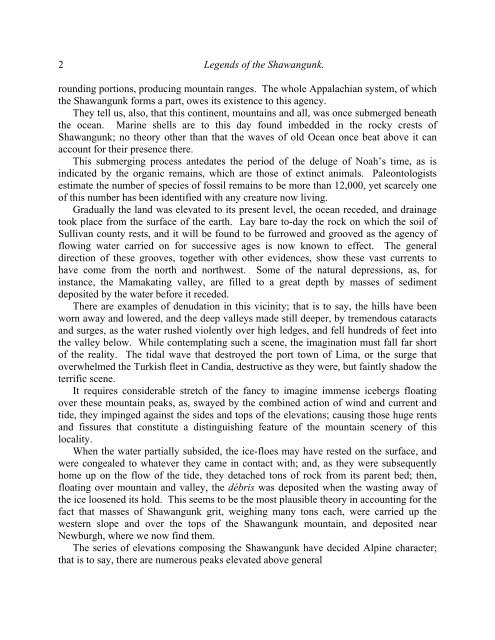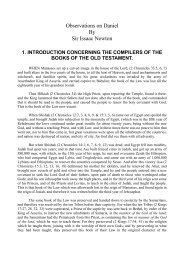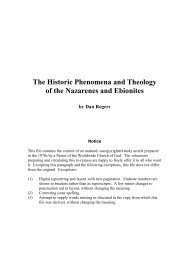Legends of the Shawangunk2 JR.pdf - Friends of the Sabbath ...
Legends of the Shawangunk2 JR.pdf - Friends of the Sabbath ...
Legends of the Shawangunk2 JR.pdf - Friends of the Sabbath ...
Create successful ePaper yourself
Turn your PDF publications into a flip-book with our unique Google optimized e-Paper software.
2 <strong>Legends</strong> <strong>of</strong> <strong>the</strong> Shawangunk.<br />
rounding portions, producing mountain ranges. The whole Appalachian system, <strong>of</strong> which<br />
<strong>the</strong> Shawangunk forms a part, owes its existence to this agency.<br />
They tell us, also, that this continent, mountains and all, was once submerged beneath<br />
<strong>the</strong> ocean. Marine shells are to this day found imbedded in <strong>the</strong> rocky crests <strong>of</strong><br />
Shawangunk; no <strong>the</strong>ory o<strong>the</strong>r than that <strong>the</strong> waves <strong>of</strong> old Ocean once beat above it can<br />
account for <strong>the</strong>ir presence <strong>the</strong>re.<br />
This submerging process antedates <strong>the</strong> period <strong>of</strong> <strong>the</strong> deluge <strong>of</strong> Noah’s time, as is<br />
indicated by <strong>the</strong> organic remains, which are those <strong>of</strong> extinct animals. Paleontologists<br />
estimate <strong>the</strong> number <strong>of</strong> species <strong>of</strong> fossil remains to be more than 12,000, yet scarcely one<br />
<strong>of</strong> this number has been identified with any creature now living.<br />
Gradually <strong>the</strong> land was elevated to its present level, <strong>the</strong> ocean receded, and drainage<br />
took place from <strong>the</strong> surface <strong>of</strong> <strong>the</strong> earth. Lay bare to-day <strong>the</strong> rock on which <strong>the</strong> soil <strong>of</strong><br />
Sullivan county rests, and it will be found to be furrowed and grooved as <strong>the</strong> agency <strong>of</strong><br />
flowing water carried on for successive ages is now known to effect. The general<br />
direction <strong>of</strong> <strong>the</strong>se grooves, toge<strong>the</strong>r with o<strong>the</strong>r evidences, show <strong>the</strong>se vast currents to<br />
have come from <strong>the</strong> north and northwest. Some <strong>of</strong> <strong>the</strong> natural depressions, as, for<br />
instance, <strong>the</strong> Mamakating valley, are filled to a great depth by masses <strong>of</strong> sediment<br />
deposited by <strong>the</strong> water before it receded.<br />
There are examples <strong>of</strong> denudation in this vicinity; that is to say, <strong>the</strong> hills have been<br />
worn away and lowered, and <strong>the</strong> deep valleys made still deeper, by tremendous cataracts<br />
and surges, as <strong>the</strong> water rushed violently over high ledges, and fell hundreds <strong>of</strong> feet into<br />
<strong>the</strong> valley below. While contemplating such a scene, <strong>the</strong> imagination must fall far short<br />
<strong>of</strong> <strong>the</strong> reality. The tidal wave that destroyed <strong>the</strong> port town <strong>of</strong> Lima, or <strong>the</strong> surge that<br />
overwhelmed <strong>the</strong> Turkish fleet in Candia, destructive as <strong>the</strong>y were, but faintly shadow <strong>the</strong><br />
terrific scene.<br />
It requires considerable stretch <strong>of</strong> <strong>the</strong> fancy to imagine immense icebergs floating<br />
over <strong>the</strong>se mountain peaks, as, swayed by <strong>the</strong> combined action <strong>of</strong> wind and current and<br />
tide, <strong>the</strong>y impinged against <strong>the</strong> sides and tops <strong>of</strong> <strong>the</strong> elevations; causing those huge rents<br />
and fissures that constitute a distinguishing feature <strong>of</strong> <strong>the</strong> mountain scenery <strong>of</strong> this<br />
locality.<br />
When <strong>the</strong> water partially subsided, <strong>the</strong> ice-floes may have rested on <strong>the</strong> surface, and<br />
were congealed to whatever <strong>the</strong>y came in contact with; and, as <strong>the</strong>y were subsequently<br />
home up on <strong>the</strong> flow <strong>of</strong> <strong>the</strong> tide, <strong>the</strong>y detached tons <strong>of</strong> rock from its parent bed; <strong>the</strong>n,<br />
floating over mountain and valley, <strong>the</strong> débris was deposited when <strong>the</strong> wasting away <strong>of</strong><br />
<strong>the</strong> ice loosened its hold. This seems to be <strong>the</strong> most plausible <strong>the</strong>ory in accounting for <strong>the</strong><br />
fact that masses <strong>of</strong> Shawangunk grit, weighing many tons each, were carried up <strong>the</strong><br />
western slope and over <strong>the</strong> tops <strong>of</strong> <strong>the</strong> Shawangunk mountain, and deposited near<br />
Newburgh, where we now find <strong>the</strong>m.<br />
The series <strong>of</strong> elevations composing <strong>the</strong> Shawangunk have decided Alpine character;<br />
that is to say, <strong>the</strong>re are numerous peaks elevated above general
















